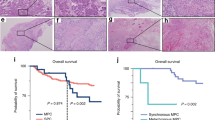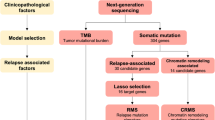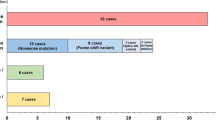Abstract
The development of second primary tumors (SPTs) in patients with head and neck squamous cell carcinoma (HNSCC) has become an increasingly important factor in clinical treatment decison. Currently, clinical and histologic parameters are used to determine whether or not SPT is present. Recent studies suggest that many SPTs in the upper aerodigestive tract have a common clonal origin, challenging the longstanding multiclonal origin concept. To determine genetic relationships among multiple oral cancerous and precancerous lesions (MOCP), we analysed 100 lesions from 26 Japanese patients. Lesion development was synchronous and metachronous. We looked for patterns of microsatellite alterations (MA) using seven markers at chromosomes 3p14, 9p21, and 17p13, where MA occurs early in oral carcinogenesis. Loss of heterozygosity (LOH) was found in 52.6% (41/78), 62.5% (60/96), and 59.3% (32/54) of informative MOCP at 3p14, 9p21, and 17p13, respectively. Microsatellite instability (MI) was observed in 11, 26 and 13% of the samples at 3p14, 9p21, and 17p13 markers, respectively. Patterns of MA were concordant in only nine (14%) of 63 lesions from four (18%) of 22 patients who initially presented with noninvasive lesions. However, two of four patients with invasive cancer as indexed lesion showed 16 (43%) clonally related MOCP among 37 lesions (P=0.003). The results suggest that the majority of MOCP arise from clonally independent cells affected by field cancerization. However, the probability of mucosal spread of clonal malignant or premalignant cells may increase along with malignant progression.
This is a preview of subscription content, access via your institution
Access options
Subscribe to this journal
Receive 50 print issues and online access
$259.00 per year
only $5.18 per issue
Buy this article
- Purchase on Springer Link
- Instant access to full article PDF
Prices may be subject to local taxes which are calculated during checkout




Similar content being viewed by others
References
Allen RC, Zoghbi HY, Moseley AB, Rosenblatt HM, Belmont JW . 1992 Am. J. Hum. Genet. 51: 1229–1239
Bedi GC, Westra WH, Gabrielson E, Koch W, Sydransky D . 1996 Cancer Res. 56: 2484–2487
Bishop JM . 1987 Science (Washington DC) 235: 305–311
Boyle J, Hakim J, Koch W, Van der Riet P, Hruban RH, Roa R, Correo R, Eby Y, Rubbert J, Sidransky D . 1998 Cancer Res. 58: 4477–4480
Buller RE, Skilling JS, Sood AK, Plaxe S, Baergen RN, Lager D . 1998 Am. J. Obstet. Gynecol. 178: 641–649
Califano J, Van der Reit P, Westra W, Nawroz H, Clayman G, Piantadosi S, Corio R, Lee D, Greenberg B, Koch W, Sidransky D . 1997 Cancer Res. 56: 2488–2492
Cianfriglia F, Di Gregorio DA, Manieri A . 1999 Oral Oncol. 35: 157–163
Chung KY, Mukhopadhyay T, Kim J, Casson A, Ro JY, Goepfert H, Hong WK, Roth JA . 1993 Cancer Res. 53: 1676–1683
Einhorn J, Wersall J . 1967 Cancer 20: 2184–2193
El-Naggar AK, Hurr K, Batsakis JG, Luna MA, Goepfert H, Huff V . 1995 Cancer Res. 55: 2656–2659
Field JK . 1996 Anticancer Res. 16: 2421–2432
Hung J, Kishimoto Y, Sugio K, Virmani A, McIntire DD, Minna JD, Gazdar AF . 1995 JAMA 273: 558–563
Jang SJ, Mao L . 2000 Cancer Res. 60: 864–866
Jones AS, Morar P, Phillips DE, Field JK, Husband D, Helliwell TR . 1995 Cancer 75: 1343–1353
Kim SK, Ro JY, Kemp BL, Lee JS, Kwun TJ, Fong KM, Sekido Y, Minna JD, Hong WK, Mao L . 1997 Cancer Res. 57: 400–403
Li X, Lee NK, Ye YW, Weber PG, Schweitzer C, Cheng QC, Nisen PD . 1994 J. Natl. Cancer Inst. 86: 1524–1529
Lydiatt WM, Anderson PE, Bazzana T, Casale M, Hughes CJ, Huvos AG, Lydiatt DD, Schantz SP . 1998 Cancer 82: 1376–1380
Mao L, El-Naggar A, Papadimitrakopoulou V, Shin H, Fan Y, Zhou X, Clayman G, Lee J, Hittelman W, Lippman S, Hong WK . 1998 J. Natl. Cancer Inst. 90: 1545–1551
Mao L, Lee JS, Fan YH, Ro JY, Batsakis JG, Lippman S, Hittelman W, Hong WK . 1996 Nature Med. 2: 682–685
Mao L, Lee DJ, Tockman MS, Erozan YS, Askin F, Sidransky D . 1994 Proc. Natl. Acad. Sci. USA 91: 9871–9875
Nawroz H, Van der Reit P, Hruban RH, Koch W, Ruppert JM, Sidransky D . 1994 Cancer Res. 54: 1152–1155
Ohta M, Inoue H, Cotticelli MG, Kastury K, Baffa R, Palozzo J, Siprashvili Z, Mori M, McCue P, Druck T, Croce C, Huebner K . 1996 Cell 84: 587–597
Prevo LJ, Sanchez CA, Galipeau PC, Reid BJ . 1999 Cancer Res. 59: 4784–4787
Roz L, Wu CL, Porter S, Scully C, Speight P, Read A, Sloan P, Thakker N . 1996 Cancer Res. 56: 1228–1231
Scholes AGM, Woolgar JA, Boyle MA, Brown JS, Vaughan ED, Hart CA, Jones AS, Field JK . 1998 Cancer Res. 58: 2003–2006
Schwartz LH, Ozahin M, Zhang GN, Touboul E, Vataire FD, Andolenko P, Lacau-Saint-Guily J, Laugier A, Schlienger M . 1994 Cancer 74: 1933–1938
Sidransky D, Frost P, von Eschenbach A, Oyasu R, Preisinger A, Vogenstein B . 1992 New Engl. J. Med. 326: 737–740
Silverman S, Gorsky M, Lozada F . 1984 Cancer 53: 563–568
Slaughter DP, Southwick HW, Smejkal W . 1953 Cancer 6: 963–968
Sozzi G, Miozzo M, Pastorino U, Pilotti S, Donghi R, Giarola M, De Gregorio L, Manenti G, Radice P, Minoletti F, Porta GD, Pierotti MA . 1995 Cancer Res. 55: 135–140
Tseng JE, Kemp BL, Khuri FR, Kurie J, Lee JS, Zhou X, Liu D, Hong WK, Mao L . 1999 Cancer Res. 59: 4798–4803
Van der Reit P, Nawroz H, Hruban RH, Corio R, Tokino K, Koch W, Sidransky D . 1994 Cancer Res. 54: 1156–1158
Vokes EE, Weichselbaum RR, Lippman SM, Hong WK . 1993 N. Engl. J. Med. 328: 184–194
Worsham MJ, Wolman SR, Carey TE, Zarbo RJ, Benninger MS, van Dyke DL . 1995 Hum. Pathol. 26: 251–261
Acknowledgements
L Mao is supported in part by National Cancer Institute PO1 CA52051. WK Hong is an American Cancer Society Clinical Research Professor.
Author information
Authors and Affiliations
Rights and permissions
About this article
Cite this article
Jang, S., Chiba, I., Hirai, A. et al. Multiple oral squamous epithelial lesions: are they genetically related?. Oncogene 20, 2235–2242 (2001). https://doi.org/10.1038/sj.onc.1204311
Received:
Revised:
Accepted:
Issue Date:
DOI: https://doi.org/10.1038/sj.onc.1204311
Keywords
This article is cited by
-
Genome-wide copy number changes and CD133 expression characterized distinct subset of colon polyps: differentiation between incidental polyps and cancer-associated polyps
International Journal of Colorectal Disease (2015)
-
p53: Revealing the Unusual Suspect: a Study and Field Cancerization Minireview
Indian Journal of Surgical Oncology (2014)
-
Oral squamous cell carcinoma in relation to field precancerisation: pathobiology
Cancer Cell International (2013)
-
DNA methylation in tumour and normal mucosal tissue of head and neck squamous cell carcinoma (HNSCC) patients: new diagnostic approaches and treatment
Medical Oncology (2013)
-
Oral field cancerization: current evidence and future perspectives
Oral and Maxillofacial Surgery (2012)



